Puppet refers to an inanimate object often resembling a human or animal figure. The form of theatre where puppets are manipulated by a human is known as puppetry. Such performance is also known as puppet play as, whatever be the form of puppet used, they are used for story telling.
History associated with Puppetry in India
- According to some historians, puppets are as old as civilisation. Some even say that in ancient civilisation of Harappa and Mohenjodaro, some terracotta figures were made to achieve some limited animation.
- For example: terracotta bull with detachable head that can be manipulated by a string, terracotta monkey that slides up and down a stick creating a vertical movement etc.
- There is reference to art of puppetry and shadow theatre in Mahabharata as a means of popular entertainment in India. Srimad Bhagavata, the great epic depicting the story of Lord Krishna in his childhood say that with three strings – Satta, Raja and Tama, the God manipulates each object in the universe as a marionette.
- The Ashokan rock edicts in the third century BCE also alluded to India as a puppet theatre.
- The great grammarian Panini laid down rules of grammar with puppets as illustrations. Even Patanjali in his Ashtadhyayi Mahabhashya gave many illustrations from the Sanskrit plays and entertainment’s of his time, which relate to the three major streams: the dance drama, the puppet theatre and the musical narrative of story telling.
- Therigatha, an old Buddhist treatise contains a clear reference to puppet theatre with string puppets having detachable limbs were made of woods.
- Natyashastra by Bharata contains reference of the Sutradhar who manipulated dolls with strings (sutras) from inside.
- Other literary works referring to dance of puppets or puppet show or of mechanized wooden dolls etc., includes the epic Shilappadikaram by llango Adigal, Kamasutra of Vatsyayana, plays like Panchala Anuyanam, Kathasaritsagar (a collection of ancient fables).
- In modern times, educationists all over the world have realised the potential of puppetry as a medium for communication.
- Many institutions and individuals in India are involving students and teachers in the use of puppetry for communicating educational concepts.
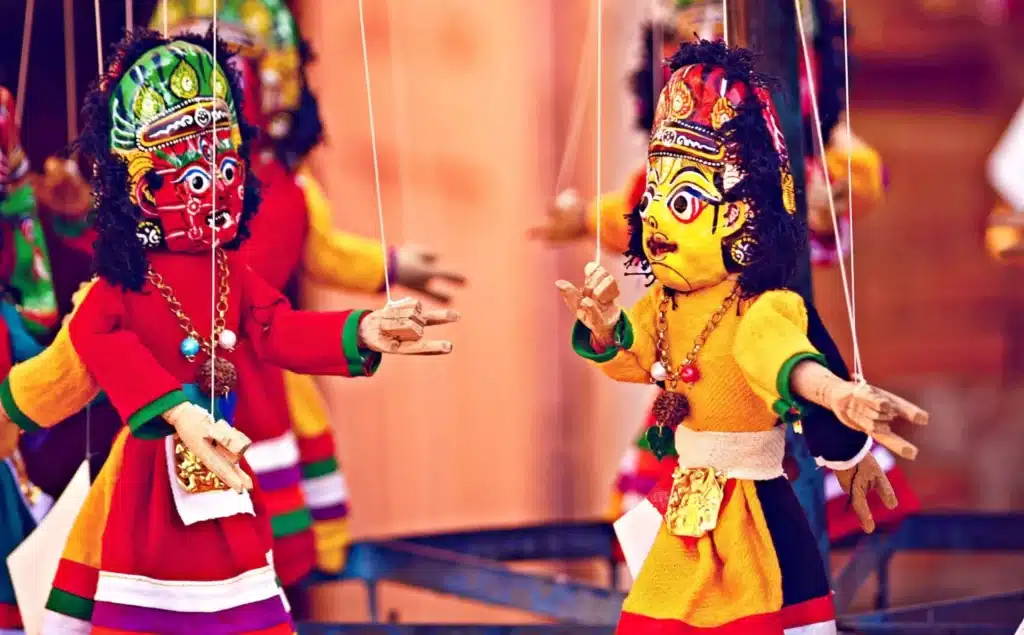
Types of Puppetry
There are many different varieties of puppets differing due to range of materials used, their form and intended use. They can be extremely complex or very simple in their construction. Almost all types of puppets are found in India. Puppets from different parts of the country have their own identity with regional styles of painting and sculpture reflected in them. If we want to categorize different types it may be divided into 4 basic kinds of puppets
- Glove puppets
- String puppets
- Rod puppets
- Shadow puppets
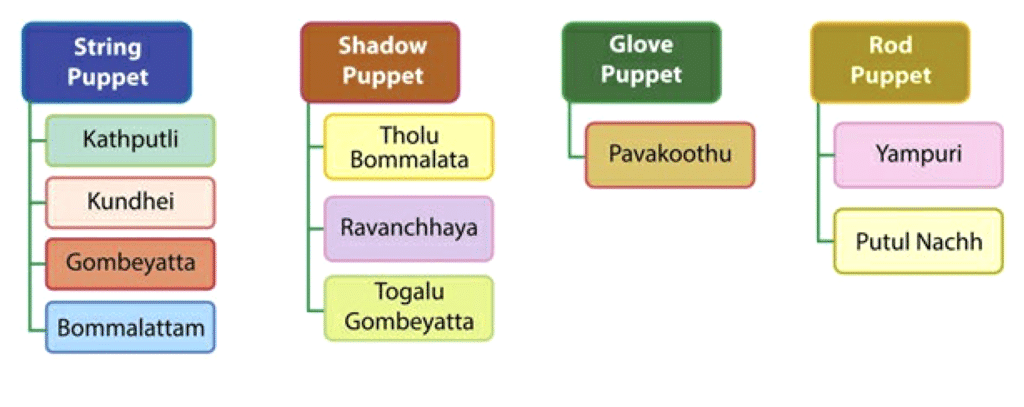
Glove Puppets
- The glove puppets are found mainly in UP, Odisha, West Bengal and Kerela. These are worn on hand and puppeteer manipulates their heads and arms with fingers.
- They are also known as sleeve, hand or palm puppets. The head is made of either paper mache, cloth or wood, with two hands emerging from just below the neck.
- The manipulation is done using the first finger inserted in the head and the middle finger and the thumb as the two arms of the puppet. With the help of these three fingers, the glove puppet comes alive.
- In Uttar Pradesh, glove puppet plays usually present social themes.
- In Odisha, plays are based on stories of Radha and Krishna. It also involves the puppeteer playing on the dholak with one hand and manipulating the puppet with the other. The delivery of the dialogues, the movement of the puppet and the beat of the dholak are well synchronised and create a dramatic atmosphere.
- In Kerala, the traditional glove puppet play is called Pavakoothu. It came into existence during the 18th century due to the influence of Kathakali, the famous classical dance-drama of Kerala, on puppet performances.
The various features in Pavakoothu are:
- The head and the arms are carved of wood and joined together with thick cloth, cut and stitched into a small bag.
- The face of the puppets is decorated with paints, small and thin pieces of gilded tin, the feathers of the peacock like actors of Kathakalli on stage in their make-up, costume and ornaments.
- The height of a puppet varies from one foot to two feet.
- The musical instruments used during the performance are Chenda, Chengiloa, llathalamand Shankhathe conch.
- The theme for Glove puppet plays in Kerala is based on the episodes from either the Ramayana or the Mahabharata.
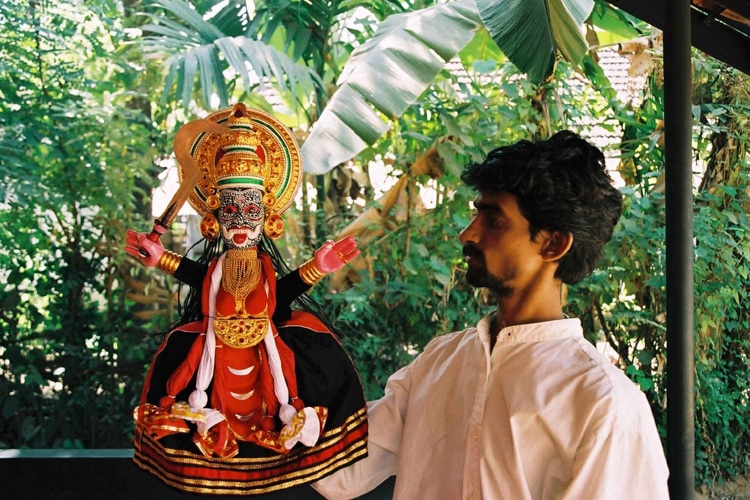
String Puppets
In this, stress is more on the manipulative skill of the puppeteer. India has a rich and ancient tradition of string puppets or marionettes. It allows greater flexibility and are, therefore, the most articulate of the puppets. Some of the regions where this form of puppetry has flourished are Rajasthan, Odisha, Karnataka and Tamil Nadu.
The features of string puppets are:
- The puppets are generally eight to nine inch miniature figures chiselled out of wood.
- Oil paint is used to paint the wood initially and to add other facial features such as eyes, lips, nose, etc.
- Small wooden pipes are created with the body to form the limbs. The body is then covered with colourful miniature dress and stitched.
- Miniature jewelleries and other accessories are attached to give it a true to- life feel.
- Strings are attached to small holes in the hands, head and back of the body which are then controlled by the puppeteer.
Kathputli
- In Rajasthan these are known as Kathputli. It is carved out of a single piece of wood and these puppets are like large dolls that are colorfully dressed in Rajasthani style. Puppeteers manipulate them with two to five strings which are normally tied to their fingers.
- Other features are:
- Their costumes and headgears are designed in the Rajasthani style of dress.
- The puppetry play is accompanied by a highly dramatised version of the regional music.
- Oval faces, large eyes, arched eyebrows and large lips are some of the distinct facial features of these string puppets.
- These puppets wear long trailing skirts and do not have legs.
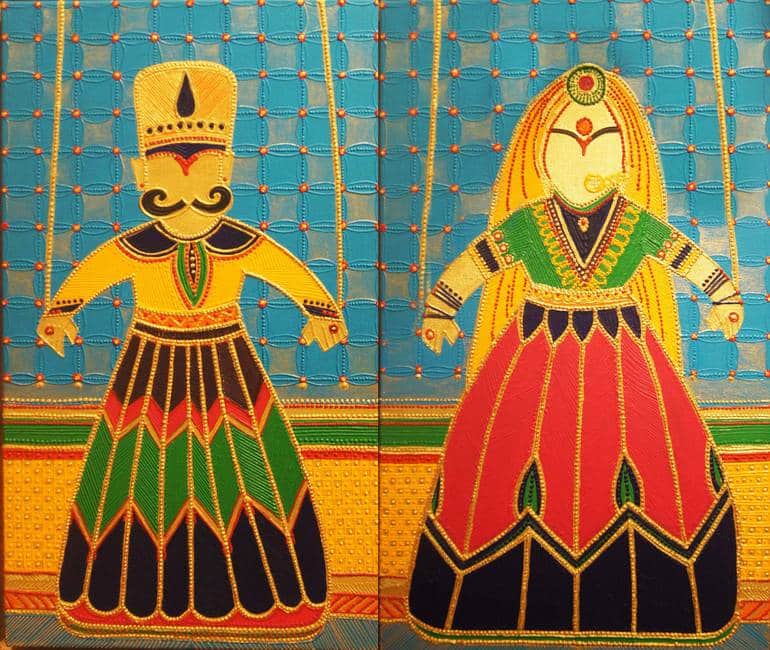
Kundhei
- In Odisha, these are known as Kundhei. It is made of light wood with no legs but wear long flowing skirts. It is also seen sometimes to be influenced by the music of Odissi dance.
- Other features are:
- They have more joints and are, therefore, more versatile, articulate and easy to manipulate.
- The puppeteers often hold a wooden prop , triangular in shape, to which strings are attached for manipulation.
- The costumes of Kundhei resemble those worn by actors of the Jatra traditional theatre.

Gombeyatta
- In Karnataka, these are called Gombeyatta. They are styled and designed like the characters of Yakshagana, the traditional theatre form of the region. Episodes enacted in Gombeyatta are usually based on Prasangas of the Yakshagana plays.
- Some features of the Gombeyatta puppet figures and puppetry are:
- The puppet figures are highly stylized and have joints at the legs, shoulders, elbows, hips and knees.
- These puppets are manipulated by five to seven strings tied to a prop.
- Some of the more complicated movements of the puppet are manipulated by two to three puppeteers at a time.
- The music that accompanies is dramatic and beautifully blends folk and classical elements.
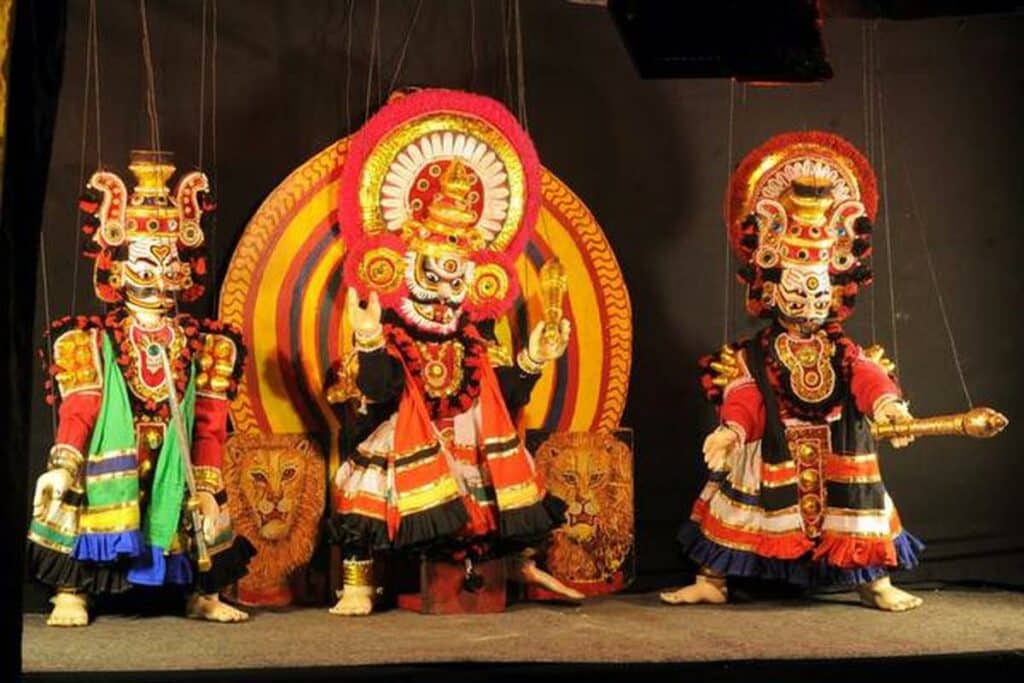
Bommalattam
- In Tamil Nadu these are known as Bommalattam.
- It combines the techniques of both rod and string puppets.
- They are made of wood and the strings for manipulation are tied to an iron ring which the puppeteer wears like a crown on his head. A few puppets have jointed arms and hands, which are manipulated by rods.
- Other features of the Bommalattam puppetry are as follows:
- The Bommalattam puppets are the largest, heaviest and the most articulate of all traditional Indian marionettes
- A puppet may be as big as 4.5 feet in height weighing about ten kilograms
- Bommalattam theatre has elaborate preliminaries which are divided into four parts – Vinayak Puja, Komali, Amanattam and Pusenkanattam.
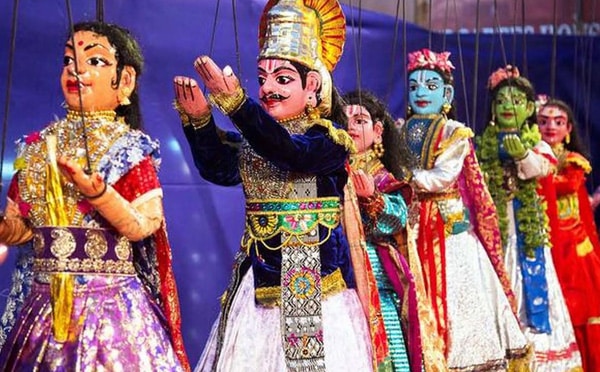
Rod puppets
Rod puppets are an extension of glove-puppets, but often much larger and supported and manipulated by rods from below. This form of puppetry now is found mostly in West Bengal and Odisha.
Putul Nautch
- In West Bengal, it is known as Putul Nautch. They are carved from wood and follow the various artistic styles of a particular region.
- In Nadia district of West Bengal, rod-puppets used to be of human size like the Bunraku puppets of Japan.
- This form is now almost extinct.
- The Bengal rod-puppets, which survive are about 3 to 4 feet in height and are costumed like the actors of Jatra, a traditional theatre form prevalent in the State.
- These puppets have mostly three joints. The heads, supported by the main rod, is joined at the neck and both hands attached to rods are joined at the shoulders.
- The technique of manipulation in this traditional form of puppetry in West Bengal is interesting and highly theatrical. A bamboo-made hub is tied firmly to the waist of the puppeteer on which the rod holding the puppet is placed.
- The puppeteers each holding one puppet, stand behind a head-high curtain and while manipulating the rods also move and dance imparting corresponding movements to the puppets.
- While the puppeteers themselves sing and deliver the stylized prose dialogues, a group of musicians, usually three to four in numbers, sitting at the side of the stage provide the accompanying music with a drum, harmonium and cymbals.
- The music and verbal text have close similarity with the Jatra theatre.
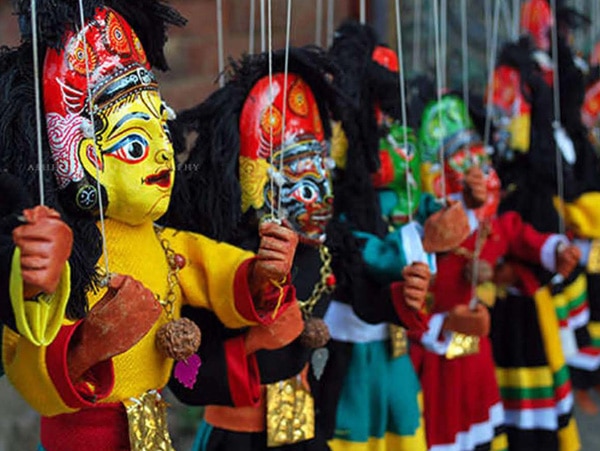
Odisha Style of Rod Puppetry
- In Odisha, the traditional rod puppetry is somewhat different from the others in the following respects:
- Here Rod puppets are much smaller in size, usually about twelve to eighteen inches.
- They also have mostly three joints, but the hands are tied to strings instead of rods. Thus elements of rod and string puppets are combined in this form of puppetry.
- The technique of manipulation is somewhat different. The Odisha rod-puppeteers squat on the ground behind a screen and manipulate.
- It is more operatic in its verbal contents since impromptu prose dialogues are infrequently used.
- Most of the dialogues are sung.
- The music blends folk tunes with classical Odissi tunes.
- The music begins with a short piece of ritual orchestral preliminary called Stuti and is followed by the play.
- The puppets of Odisha are smaller than those from Bengal or Andhra Pradesh. Rod puppet shows of Odisha are more operatic and prose dialogues are seldom used.
Yampuri
- In Bihar, the traditional Rod puppet is known as Yampuri. It has following unique features which make it an interesting watch.
- These puppets are made of wood.
- Unlike the traditional Rod puppets of West Bengal and Odisha, these puppets are in one piece and have no joints.
- As these puppets have no joints, the manipulation is different from other Rod puppets and requires greater dexterity.
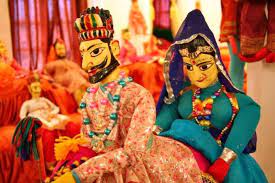
Shadow Puppets
India has the richest variety of types and styles of shadow puppets. Shadow puppets are flat figures. They are cut out of leather, which has been treated to make it translucent. Shadow puppets are pressed against the screen with a strong source of light behind it.
The manipulation between the light and the screen make silhouettes or colourful shadows, as the case may be, for the viewers who sit in front of the screen. This tradition of shadow puppets survives in Odisha, Kerala, Andhra Pradesh, Karnataka, Maharashtra and Tamil Nadu.
Togalu Gombeyatta
- In Karnataka, it is known as Togalu Gombeyatta.
- Togalu gombeyaata translates to “a play of leather dolls” in the native language of Kannada.
- These puppets are mostly small in size.
- The puppets however differ in size according to their social status, for instance, large size for kings and religious characters and smaller size for common people or servants.
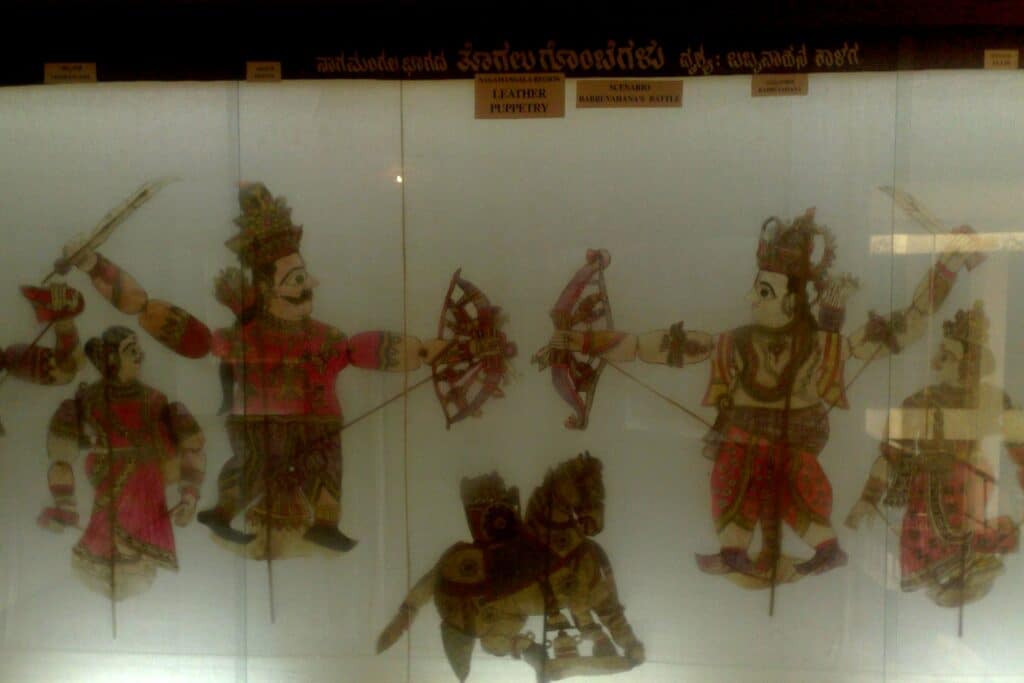
Tholu Bommalata
- In Andhra Pradesh, shadow theatre is known as Tholu Bommalata. The show is accompanied by a
musically classic background and is themed around mythological and devotional tales of the Epics and Puranas. - It has the richest and strongest tradition with following features:
- The puppets are large in size. They are made to have jointed waist, shoulders, elbows and knees.
- They are coloured on both sides. Hence, these puppets throw coloured shadows on the screen.
- The music is dominantly influenced by the classical music of the region.
- The theme of the puppet plays are drawn from the Ramayana, Mahabharata and Puranas.

Ravanachhaya
- In Odisha, it is known as Ravanachhaya.
- Although, Ravanachhaya puppets are smaller in size-the largest not more than two feet have no jointed limbs, they create very sensitive and lyrical shadows.
- It is the most theatrically exciting shadow theatre with the following features:
- The puppets are in one piece and have no joints.
- They are not coloured, hence throw opaque shadows on the screen.
- The manipulation requires great dexterity, since there are no joints.
- The puppets are made of deer skin and are conceived in bold dramatic poses.
- Use of non-human puppets such as trees and animals is common. Apart from human and animal characters, many props such as trees, mountains, chariots, etc. are also used.
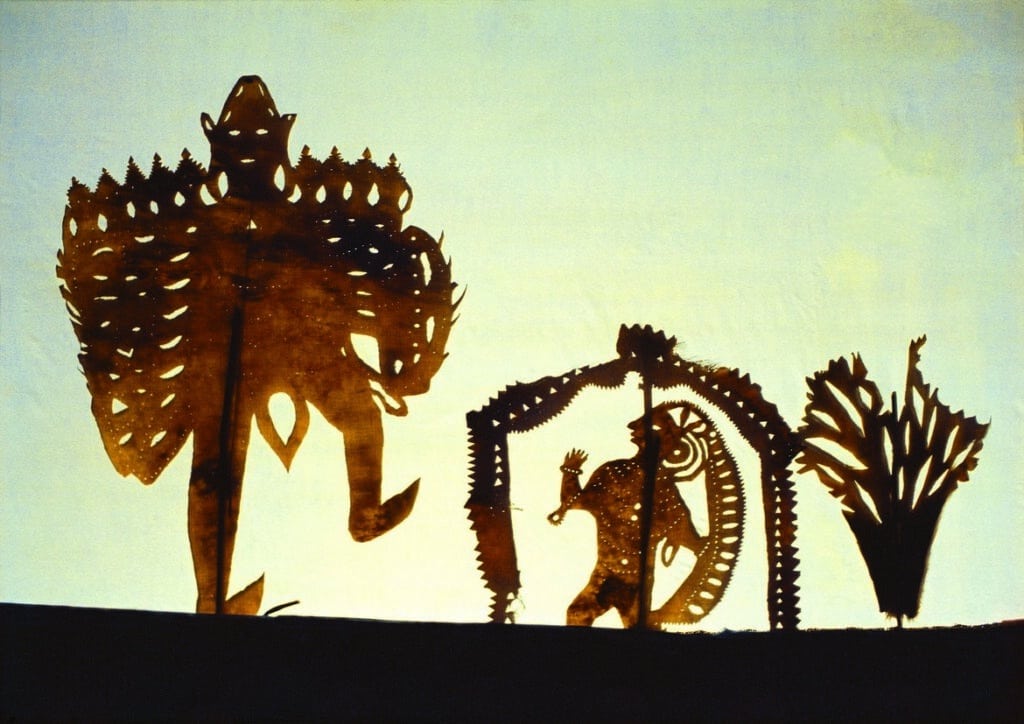
Union Internationale de la Marionnette (UNIMA)
- Union Internationale de la Marionnette (UNIMA) or International Puppetry Association was founded in Prague in 1929.
- It is affiliated to UNESCO and is a member of the International Theatre Institute.
Digital puppetry
- Digital puppetry is the manipulation and performance of digitally animated 2D or 3D figures and objects in a virtual environment that are rendered in real time by computers.
- It is most commonly used in filmmaking and television production.
- It has also been used in interactive theme park attractions and live theatre.
- The exact definition of what is and is not digital puppetry is subject to debate among puppeteers and computer graphics designers.
- However, it is generally agreed that digital puppetry differs from conventional computer animation in that it involves performing characters in real time, rather than animating them frame by frame.

Good